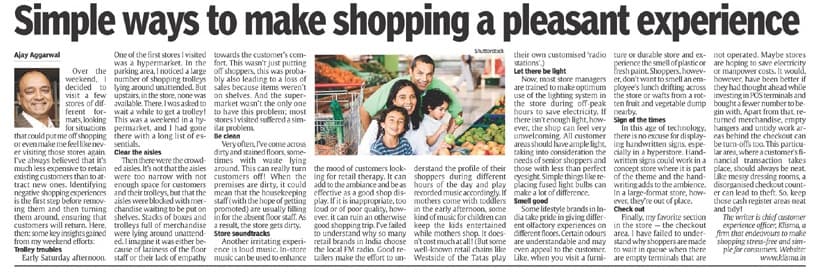Over the weekend, I decided to visit a few stores of different formats, looking for situations that could put me off shopping or even make me feel like never visiting those stores again. I’ve always believed that it’s much less expensive to retain existing customers than to attract new ones. Identifying negative shopping experiences is the first step before removing them and then turning them around, ensuring that customers will return. Here, then: some key insights gained from my weekend efforts:

Trolley troubles
Early Saturday afternoon. One of the first stores I visited was a hypermarket. In the parking area, I noticed a large number of shopping trolleys lying around unattended. But upstairs, in the store, none was available. There, I was asked to wait a while to get a trolley! This was a weekend in a hypermarket, and I had gone there with a long list of essentials.
Clear the aisles
Then there were the crowded aisles. It’s not that the aisles were too narrow with not enough space for customers and their trolleys, but that the aisles were blocked with merchandise waiting to be put on shelves. Stacks of boxes and trolleys full of merchandise were lying around unattended. I imagine it was either because of laziness of the floor staff or their lack of empathy towards the customer’s comfort. This wasn’t just putting off shoppers, this was probably also leading to a loss of sales because items weren’t on shelves. And the supermarket wasn’t the only one to have this problem; most stores I visited suffered a similar problem.
Be clean
Very often, I’ve come across dirty and stained floors, sometimes with waste lying around. This can really turn customers off! When the premises are dirty, it could mean that the housekeeping staff (with the hope of getting promoted) are usually filling in for the absent floor staff. As a result, the store gets dirty.
Store soundtracks
Another irritating experience is loud music. In-store music can be used to enhance the mood of customers looking for retail therapy. It can add to the ambiance and be as effective as a good shop display. If it is inappropriate, too loud or of poor quality, however, it can ruin an otherwise good shopping trip. I’ve failed to understand why so many retail brands in India choose the local FM radio. Good retailers make the effort to understand the profile of their shoppers during different hours of the day and play recorded music accordingly. If mothers come with toddlers in the early afternoon, some kind of music for children can keep the kids entertained while mothers shop. It doesn’t cost much at all! (But some well-known retail chains like Westside of the Tatas play their own customised ‘radio stations’.)
Let there be light
Now, most store managers are trained to make optimum use of the lighting system in the store during off-peak hours to save electricity. If there isn’t enough light, however, the shop can feel very unwelcoming. All customer areas should have ample light, taking into consideration the needs of senior shoppers and those with less than perfect eyesight. Simple things like replacing fused light bulbs can make a lot of difference.
Smell good
Some lifestyle brands in India take pride in giving different olfactory experiences on different floors. Certain odours are understandable and may even appeal to the customer. Like, when you visit a furniture or durable store and experience the smell of plastic or fresh paint. Shoppers, however, don’t want to smell an employee’s lunch drifting across the store or wafts from a rotten fruit and vegetable dump nearby.
Sign of the times
In this age of technology, there is no excuse for displaying handwritten signs, especially in a hyperstore. Handwritten signs could work in a concept store where it is part of the theme and the handwriting adds to the ambience. In a large-format store, however, they’re out of place.
Check out
Finally, my favorite section in the store — the checkout area. I have failed to understand why shoppers are made to wait in queue when there are empty terminals that are not operated. Maybe stores are hoping to save electricity or manpower costs. It would, however, have been better if they had thought ahead while investing in POS terminals and bought a fewer number to begin with. Apart from that, returned merchandise, empty hangers and untidy work areas behind the checkout can be turn-offs too. This particular area, where a customer’s financial transaction takes place, should always be neat. Like messy dressing rooms, a disorganised checkout counter can lead to theft. So, keep those cash register areas neat and tidy!
From a series of articles commissioned by DNA (Money) dated 22 February 2012.


You must be logged in to post a comment.